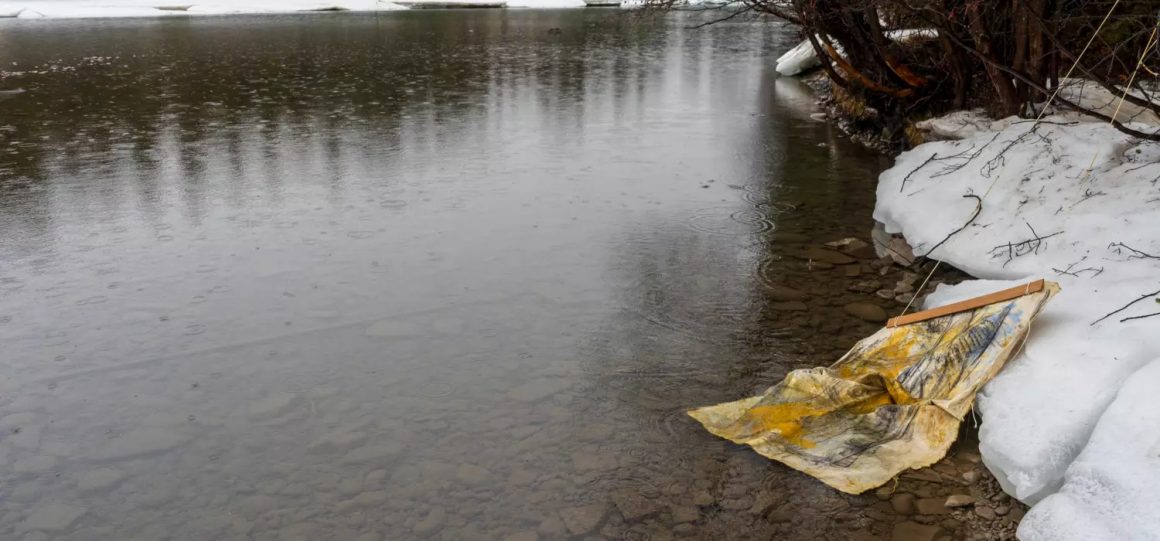
Highlights of Brackish: A transdisciplinary exploration of water
By Leonie O’Sullivan, March 20 2024—
Brackish water can be formed by mixing fresh and saltwater and is characterized by its intermediate salinity. While brackish water can pose challenges, it also serves as a home for adaptable and versatile flora and fauna. This concept inspired the creation of an interdisciplinary event, bringing together academics with diverse skill sets to celebrate and discuss water-related research. The Brackish exhibition included the Faculty of Arts, Science, and the School of Architecture, Planning, and Landscape representatives.
The exhibition was curated by two students from the Department of Geography: Tanya Yeomans, a Masters of Science student, and Samantha Jones, a Ph.D. candidate. I attended the exhibition held from Mar. 6 to 14 in the Arts Building, and my favourites are shared below.
Curbside, by Karly Ross
This eye-catching exhibit presents a personal, multimedia exploration of mobility and disability, shedding light on how the harsh Albertan winter intensified the challenges of living with a disability. A series of photographs captures the familiar snow, ice and slush elements that define this season. Ross broke their ankle and suffered complications that led to a two-week stay in the ICU. Below the photographs, a woven timeline illustrates the snow accumulation and daily temperatures over six weeks following their hospitalization.
Through personal reflections, Ross shares insights into their healing journey, offering their perspectives on how a visible disability influenced their day-to-day life. They acknowledge their privilege, which may have ultimately saved their life, and emphasize the transient nature of both ableness and mobility, reminding us that these can change in an instant.
Fragmented Arctic charr, by Megan Leung
This piece is colourful, vibrant and beautiful, sharply contrasting the reality it depicts. Arctic charr, or Iqaluk, is a coldwater fish crucial to northern populations as a food source and a preserver of the knowledge and traditional ways of Indigenous peoples. The multimedia exhibit features two Arctic charrs: one undergoing a transition to a skeleton form, and the other spiralized and hollowed out, symbolizing the concerning future approaching this fish.
The Iqaluk face higher mortality rates due to rising water temperatures brought on by global warming and ocean acidification due to increased carbon dioxide levels. Additionally, the fragmentation and loss of their habitats pose a severe threat. The Iqaluk is at risk of one day becoming an endangered fish, underscoring the urgent need for conservation efforts.
Illustration contributed to Bees’ bodies, water bodies, lament and hope in Maya territories, by Veronica Hoil Briseño
This illustration encapsulates the endangered biodiversity within the Maya territories. Picture a deer adorned with the wings of a stingless bee and a corn-shaped body, leaping gracefully above splashes of water, with antlers transformed into tree branches full of flowers. The artwork displays remarkable talent while seamlessly integrating the at-risk plant and animal life into a cohesive being.
The back hooves spiral into DNA double helices, sparking the thought that we all have the same building blocks on a molecular level. The artwork serves as an important reminder of the intrinsic value of preserving every plant and animal, emphasizing the universal importance of conservation efforts.
The Brackish exhibition showcased so many talented University of Calgary community members — too many to provide them all with the recognition they deserve. This exhibition highlighted the unifying power of water, transcending our individual specialties and hosting a diverse array of issues. I hope this exhibition may act as a catalyst for more transdisciplinary exhibits across our campuses, fostering powerful and collaborative research to tackle the world’s complex challenges.
